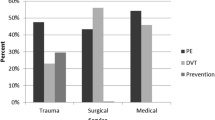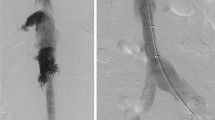Abstract
Background
An Inferior vena cava filter (IVCF) provides prophylaxis against pulmonary embolism in patients that cannot be anticoagulated. A removable IVCF (R-IVCF) provides prophylaxis during a high-risk period while potentially eliminating long-term complications associated with a permanent IVCF. Factors influencing success of R-IVCF removal are ill-defined.
Methods
The study was a retrospective review of a prospectively maintained patient registry comprising patients who received an R-IVCF (Bard RecoveryTM and G2TM) at an academic level 1 trauma center. The influence of time in vivo, filter design, and filter head position on computed abdominal tomographic (CAT) scan (touching caval wall vs. free) on removal success was examined.
Results
Ninety-two patients each received an R-IVCF. Thirty-nine patients underwent removal attempt and 30 R-IVCFs were removed. Time in vivo did not affect removal success (success: 228 ± 104 days versus unsuccessful: 289 ± 158 days, p = 0.18). Filter design impacted filter head position (Recovery: 43% touching versus G2: 6% touching, p = 0.023). Position of the filter head influenced removal success (touching: 50% success versus free: 88% success, p = 0.021).
Conclusions
Position of the filter head is the key determinant of removal success. Specific device designs may impact filter head position as was the case with the two designs in this analysis. Time in vivo does not affect removal success.


Similar content being viewed by others
References
Becker DM, Philbrick JT, Selby JB (1992) Inferior vena cava filters: Indications, safety, effectiveness. Arch Intern Med 152:1985–1994
Corriere MA, Sauve KJ, Ayerdi J et al (2007) Vena cava filters and inferior vena cava thrombosis. J Vasc Surg 45:789–794
Geerts WH, Code KI, Jay RM et al (1994) A prospective study of venous thromboembolism after major trauma. N Engl J Med 331:1601–1606
Giannoudis PV, Pountos I, Pape HC et al (2007) Safety and efficacy of vena cava filters in trauma patients. Injury 38:7–18
Greenfield LJ, Proctor MC (1995) Twenty-year clinical experience with the Greenfield filter. Cardiovasc Surg 3:199–205
Karmy-Jones R, Jurkovich GJ, Velmahos GC et al (2007) Practice patterns and outcomes of retrievable vena cava filters in trauma patients: an AAST multicenter study. J Trauma 62:17–24
Meier C, Keller IS, Pfiffner R et al (2006) Early experience with the retrievable OptEase vena cava filter in high-risk trauma patients. Eur J Vasc Endovasc Surg 32:589–595
Quirke TE, Ritota PC, Swan KG (1997) Inferior vena caval filter use in US trauma centers: a practitioner survey. J Trauma 43:333–337
Rogers FB, Cipolle MD, Velmahos G et al (2002) Practice management guidelines for the prevention of venous thromboembolism in trauma patients: the EAST practice management guidelines work group. J Trauma 53:142–164
Sing RF, Adrales G, Baek S et al (2001) Guidewire incidents with inferior vena cava filters. J Am Osteopath Assoc 101:231–233
Sing RF, Camp SM, Heniford BT et al (2006) Timing of pulmonary emboli after trauma: implications for retrievable vena cava filters. J Trauma 60:732–734
Ashley DW, Gamblin TC, Burch ST et al (2001) Accurate deployment of vena cava filters: comparison of intravascular ultrasound and contrast venography. J Trauma 50:975–981
Ashley DW, Gamblin TC, McCampbell BL et al (2004) Bedside insertion of vena cava filters in the intensive care unit using intravascular ultrasound to locate renal veins. J Trauma 57:26–31
Acknowledgment
This work was supported by NIH Grant R01 GM53439 (KAK).
Author information
Authors and Affiliations
Corresponding author
Rights and permissions
About this article
Cite this article
Hermsen, J.L., Ibele, A.R., Faucher, L.D. et al. Retrievable Inferior Vena Cava Filters in High-Risk Trauma and Surgical Patients: Factors Influencing Successful Removal. World J Surg 32, 1444–1449 (2008). https://doi.org/10.1007/s00268-007-9462-z
Published:
Issue Date:
DOI: https://doi.org/10.1007/s00268-007-9462-z




